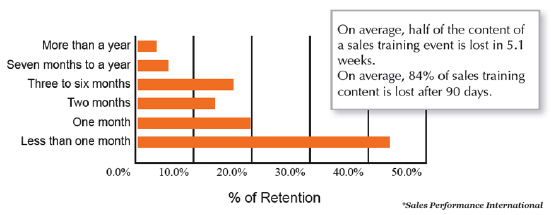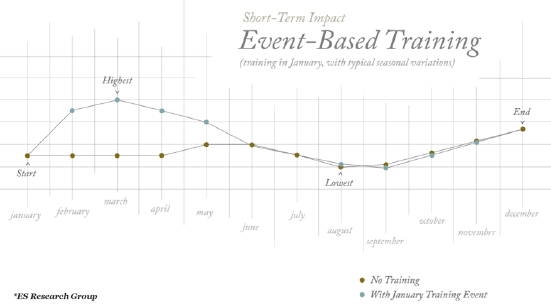With regular turnover and today’s changing sales environment, you can’t remain competitive without continually upgrading the skills of your sales team.
We are all aware that training is an essential part of developing your sales force. With regular turnover and today’s changing sales environment, you can’t remain competitive without continually upgrading the skills of your sales team.
The annual investment in sales training in the US is estimated to be more than $5 billion. This means that on average, US companies spend about $5,000 per sales performer annually, including the cost of travel, materials and time away from the job. Dave Stein, a highly respected learning and development consultant has suggested that upwards of 92% of all training goes to waste. The reason – nothing changes AFTER the training. That means the bulk of the skills experienced in the classroom never get transferred back to the job. In other words, there is no learning to life.
Learning transfer is the ongoing application of new knowledge and skills to on-the-job performance, leading to the improved business results initially targeted by the training.
In order for learning transfer to occur, the student must both retain knowledge of concepts learned and choose to apply them on the job. If the learner can recite the concepts or processes learned in class but does not use them, training retention has occurred but learning transfer has not. After all, the ultimate goal of training is to change and improve behavior. If skills learned in training are not applied or are applied ineffectively, then the training has limited to no impact.
Another way to look at learning transfer is through the following equation:
- Training Results = Learning x Transfer
Research by Sales Performance International shows that approximately 16% of unreinforced training content is retained after 90 days, on average. (See chart below).

According to The 120-Day Curse, an e-book by Dave Stein, somewhere between 85 and 90% of sales training has no lasting impact after 120 days.

So what is the solution to the learning transfer problem? How can you maximize the significant investment in any sales training effort? There is no single practice that will dramatically increase learning transfer by itself. However, there are several things you can do before, during and after sales training that will have a combined, lasting impact, whether you are delivering in-house or vendor-led training.
Before Training
1. Obtain participation and buy-in
- Involve manager and employee representatives in selecting, designing and/or tailoring the training
- Ensure senior management support of the initiative and willingness to hold their direct reports (usually mid-level managers) responsible for change
- Employ a communication cascade whereby the initiative benefits are shared with all levels of the organization, starting with communications from senior management. Goals and benefits should be discussed regularly in large and small group meetings, newsletters and other communication vehicles
- Show how training objectives are aligned with the organization’s mission, values and strategic objectives
2. Modify the work environment
- Adjust job descriptions, incentive systems and performance evaluations as appropriate to reflect new performance expectations after training
- Ensure sales and marketing materials support the new approach
- Modify the CRM as needed to mirror new prospecting strategies and conversation models and to effectively track implementation/usage
3. Prepare sales managers
- Communicate the training goals, structure and benefits well in advance. Listen to and address any manager concerns.
- Ensure that managers have the necessary skills to effectively coach learners before and after they attend training.
- Allow managers the opportunity to attend training along with their employees.
4. Distribute preparation activity (prework) and make learners accountable to complete it
- Prime the pump and get learners in the right mindset with a relevant reading and application assignment
- Keep the preparation activity brief and engaging. Make sure it is relevant to the training and will be actively referenced and used during class
5. Arrange pre-training conferences
- Outline expectations for managers to meet with learners a week or two prior to the training
- Provide an agenda for the pre-training conference:
- Review training purpose and benefits
- Outline manager expectations (e.g., active participation, avoid interruptions, etc.)
- Arrange for appropriate coverage of work assignments while employee is away to minimize distractions during the workshop
- Establish learner-specific focus and goals
- Check for preparation activity completion
During Training
1. Create a productive learning environment
- Arrange tables in a U-shape or “pods” layout to facilitate class discussion
- Adjust lighting, temperature, etc., as needed
- Establish ground rules for cell phones, breaks, etc. to prevent interruptions and distractions
- Make certain that managers are:
- Engaged in the class along with their colleagues to be certain they know what to coach on a post training basis
- Let colleagues learn and don’t continually pull them out of class for “emergencies”
2. Reinforce buy-in
- Where possible, have a senior manager open the session and reinforce its importance in terms of organizational objectives
- Early on, encourage discussion around specific employee benefits, or “what’s in it for me?”
3. Ensure adequate time for practice
- One of the most effective methods for learning transfer is realistic practice. The closer the practice activity to real-life situations, the more easily and quickly skills will be applied on-the-job. To this end, incorporate realistic case studies or role-plays and be sure to include an opportunity for feedback
- Where possible, have employees bring and work on actual customer situations or “deals.”
- Allow ample time for practice. Don’t allow requests for extra-long breaks, early departures, or unnecessarily long discussions to derail a strong agenda. Likewise, avoid the temptation to insert unrelated subject matter (department updates, etc.) at the beginning of the session, detracting from valuable practice time later in the course
4. Provide job aids
- Quick reference guides and checklists greatly facilitate the initial application of knowledge and skill, as employees gradually transform the new approach into a habit
- Job aids help employees look practiced and skilled in front of the customer, even when they are novices. This helps to overcome a big obstacle in the initial use of new behaviors; after all, no one wants to look like a trainee in front of the customer
5. Allow time for action planning
Encourage learners to create a detailed plan for applying new skills on the job before they leave the training session
- Action plans should include:
- Key learning points (as identified by the learner)
- Specific action steps they will implement on-the-job to apply key knowledge and skills
- Who will be involved in each action step and a target date for completion
After Training
1. Ensure manager support and reinforcement
- Encourage consistent modeling of new skills
- Arrange for a post-training conference between the manager and employee to review and finalize the action plan started during training. This is best done within 48 hours after class
- Support consistent follow-up observation and coaching by managers (best reinforced through an accountability chain from senior management to the front-line)
2. Obtain participation and buy-in
- The faster employees apply new knowledge and skills, the less likely they are to forget them. In addition, most people need to consciously practice a skill many times in a relatively short period in order for it to become routine and automatic
- If sufficient real-life application opportunities do not present themselves naturally, create them. Have employees plan specific relevant sales situations (such as prospect calls) where possible, or direct managers to engage in role-plays with their employees
3. Provide refresher training
- Although initial sales training is most effective when delivered in a classroom setting, refresher training can take many forms: podcasts, webinars, sales meetings, etc.
- Refresher training ensures that participants have an opportunity to revisit and refocus their efforts around key concepts and skills, engage in additional practice opportunities, share successes and strategies, discuss and address challenges, and ask questions as needed
4. Recognize and reward learning transfer/celebrate early wins
- Initial learning transfer is hard and does not typically feel natural or result in immediate, complete success. That’s why it’s important to recognize small, early wins in order to encourage continued application
- Recognizing early adopters and sharing their best practices encourages others to jump on board
- Where possible, use the CRM system to identify the adoption of new activities and behaviors and provide reinforcement
5. Ensure peer support
- Encourage learners to develop support networks during training. After training, facilitate the exchange of ideas between peers via online discussion forums
- Identify and develop mentors or “champions” of the new approach, who will consistently model new skills and share best practices
- Develop a culture of peer coaching and reinforcement
The time and effort you invest in these strategies significantly increase the return on your training investment. They will also contribute to stronger partnerships between key stakeholders, such as senior, middle and front-line management, HR, Training & Development and the end learner/sales performer.

